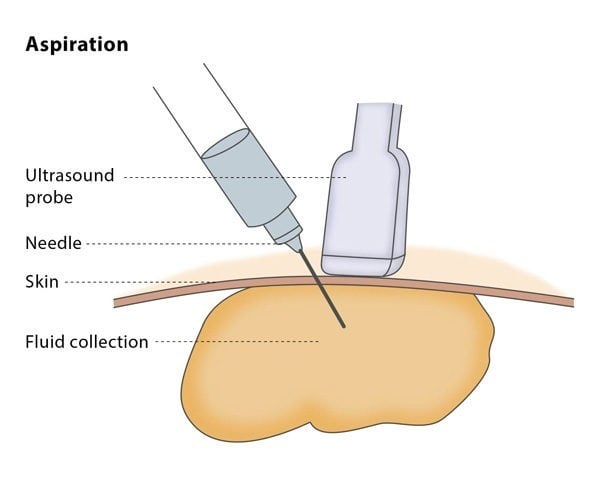Aspiration
What is aspiration?
Aspiration is the image-guided puncture of a fluid lesion (such as a cyst or an abscess) or solid lesion in order to remove a fluid or tissue sample with a small needle.
How does the procedure work?
Depending on the location of the lesion, you may be asked to stop taking any medication that prevents blood clotting.
You should not eat anything for at least four hours before the procedure. You may be asked to fast for longer, depending on the puncture and whether the procedure is particularly complicated.
The interventional radiologist may use one of a number of image guidance techniques to plan and monitor the placement of the needle during the aspiration procedure, including ultrasound, CT, MRI and fluoroscopy. You will lie down for the procedure – the exact position you will be asked to lie in depends on the access route that the interventional radiologist will use to safely approach the lesion.
Aspiration is usually performed under local anaesthesia. You may be asked to take antibiotics beforehand to reduce the risk of infection.
The procedure will be carried out in a sterile and safe environment. The interventional radiologist will use image guidance to insert a needle until the needle tip is inside the lesion. The interventional radiologist will then use a syringe to remove the sample or cyst.
Aspiration can be performed as an in-patient or out-patient procedure. The puncture site will be monitored for 2-4 hours to check for bleeding. You may experience some mild discomfort at the puncture site during the first few hours following the procedure.

Why perform it?
You may be recommended to have an aspiration procedure for diagnostic reasons (to provide information on the nature of the lesion) or for therapeutic purposes, such as removal of the fluid collection or cyst. Aspiration is sometimes preferred over drainage of small abscesses (less than 3-4 cm) for which a drainage catheter would be unsuitable.
Aspiration may not be the best option for you if you have a blood clotting disorder or when there is no safe access route.
What are the risks?
Small needles are used for the procedure, making the complication rate very low. The most common side effects are bruising, infection, and, in the case of lung aspiration procedures, pneumothorax (the collection of air in the space between the chest wall and the lung).
If the aspiration was used to treat an abscess, you may experience procedure-related sepsis (widespread inflammation in the body due to bacteria entering the bloodstream), but the risk of this is lower than with drainage procedures.
